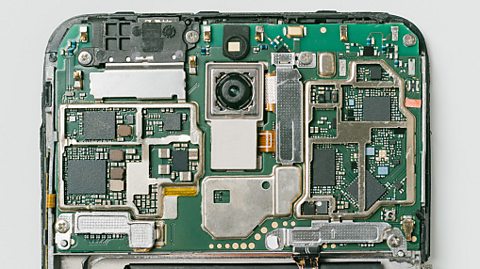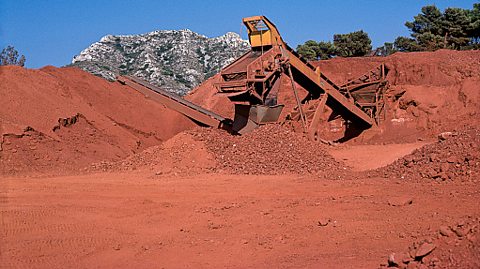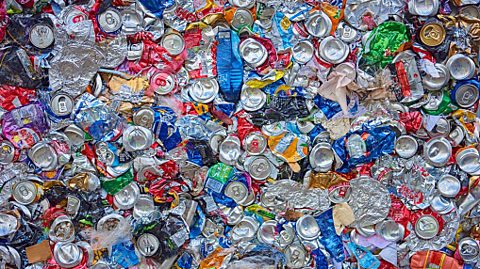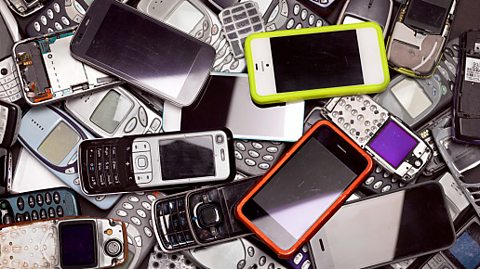Introduction to resources from the Earth
Key points
- Many of the resources we extract from the Earth are finite.
- Data shows us which resources are at risk of running out quickly.
- Recycling is one way we can reduce the extraction of finite resources.
A video about resources from the Earth
A video that looks at how many commonly used metals such as indium, lithium and cobalt can be recycled and reused
There are a number of resources that we extract from the Earth.
These include things like: wood, fossil fuels, rocks, plants and metals.
Some of these, like plants and wood are renewable resources. Plants can be replanted, and we can get more wood by growing trees.
But resources like fossil fuels and metals cannot be replaced. Once they are extracted and used we cannot make any more. They are non-renewable.
Metals such as indium, lithium and cobalt are extracted from the Earth and used to make a range of electronic devices such as laptops, tablets and phones. But as demand is growing for devices these metals are running out.
I have here an illustration that has been created using lots of data from across the globe. So what does it tell us?
I’m making this film in 2022. So the first thing that I notice here is that if manufacturing continues to grow in the same way as it was in the run up to 2011, when this data was gathered, all fossil fuels would be used up by about 2057 – well within my lifetime!
I also notice that indium, that is used to make touch screens, is expected to run out in the next five years or so, that’s by 2027, which is before some of you will be finished school.
When we look at data like this it’s important to ask how accurate and reliable it is.
The data used in this infographic is based on estimates or best guesses.
No one can be sure exactly how much of each resource we have left or how quickly we are using them.
However, as this data has come from reliable sources it feels safe to conclude that important natural resources are running out and some of them are at risk of running out very soon, unless we make changes.
So we need to try to reduce how much of these resources we extract from the Earth.
Old phones and used metals can be recycled and reused so that we don't need to extract more of them from the Earth.
Recycling also uses much less energy than extracting resources from the Earth and doesn't involve habitat destruction, that is why recycling technology is so important.
Finite resources are resources that will eventually run out. What is another name for finite resources?
Non-renewable.
Finite resources are also known as non-renewable resources because they take millions of years to form. When they have been used up they are effectively gone forever.
Finite and renewable resources
Humans extract many resources from the Earth that can then be turned into useful substances or products. Resources are extracted from the air (atmosphere), water and land.
Some resources are finiteSomething that has a limited number of uses before it is depleted. For example, oil is a finite resource.. However, others are renewableSomething that can be replaced quickly. For example, there is a continuous supply of wind which makes it a renewable form of energy..
1. Finite resources

Lots of the resources that humans use are finite. This means their supply is limited and they will eventually run out.
For example, slate is a type of stone used in building and is often used for roof materials. Slate isextract The action of removing something from somewhere, such as extracting iron ore from the ground. fromquarryAn open mine where materials, such as types of rock, are extracted from the ground. and will eventually run out, so it's a finite resource.

2. Renewable resources

Some resources are renewable which means they can be replaced.
Wood is used in building. It is not a finite resource as more wood can be used by growing more trees. Wood is a renewable resource.
However, it's important to still use wood sustainably. This means not using it up any faster than it can grow back.

Why are types of stone like sandstone and slate finite resources?
Stone cannot be grown and is therefore a finite resource.
It is mined from quarries and will eventually run out.
Using up resources
How quickly a resource is depleted (used up) depends on two main factors:
- how much of the resource there currently is
- how quickly it is being used up
Some resources are at risk of rapid depletion because they are scarce or being used up quickly.
The table shows some data demonstrating the number of years until a particular resource is depleted (used up). Data for the current amount of a resource is used to calculate these timeframes.
| Finite resource | Years until depleted (current level of use) | Years until depleted (increased level of use) |
|---|---|---|
| Aluminium | 1780 | 100 |
| Copper | 14 | 3 |
| Oil | 18 | 10 |
| Gas | 39 | 13 |
| Coal | 100 | 20 |
| Indium | 50 | 10 |
The second column shows how many years it would take for the resource to be completely used up if we carry on using it at the current level.
The third column shows how many years it would take for the resource to be used up if we start to use it more quickly than we are currently doing.
For example, the speed of depletionDepletion is when a resource is used up. would increase if there was a greater demand for the resource (due to a larger population) or if the resource started to be used in a new technology.
As the data shows, some of the resources are at risk of rapid depletion. Unless the way that they are used is changed, both copper and oil could be depleted in less than 20 years. Aluminium, on the other hand, is not at high risk of depletion.

Did you know?
Indium is a rare metal used in flat screen displays like mobile phones and TVs, as well as solar panels and batteries. Demand for indium is increasing as people buy more electronic products. This has led to mineralA solid compound which occurs naturally in rocks. containing indium being classified as critical minerals.


What name is given to minerals which contain finite resources that are in danger of getting used up very quickly?
Critical minerals.
These minerals are mineral resources that are essential to society.
Extract more or recycle?
recyclingConverting waste into reusable material. is one way that we can reduce the amount of finite resources being extracted from the Earth.
For example, there are two options for what could happen to an empty aluminium drink can:
It could be thrown in the bin and end up in a landfillMost rubbish is disposed of in landfill which involves digging a large hole in ground and burying it. site. If this happens a new aluminium can will need to be made to replace it, so that more drinks can be sold. More aluminium will need to be extracted from the Earth’s crust to meet this demand.
The can could be recycled so that the aluminium metal it contains can be used to make a new can.
1. Extracting more resources from the Earth

The first option means more aluminium would need to be extracted:
- aluminium is extracted from minerals found in the Earth’s crustThe Earth’s crust is the rocky outer layer of the Earth.
- these minerals contain compoundA pure substance made from two or more elements which are chemically bonded in a fixed ratio. of aluminium, in which the aluminium atomThe smallest particle of an element. We often think of atoms as tiny spheres, but in fact they are made from smaller particles called protons, neutrons and electrons. are chemically bonded to other atoms
- the extraction process involves separating the aluminium atoms from these other atoms, which requires lots of electricity

2. Recycling

The second option (recycling) stops the need to extract more.
Recycling an aluminium can into usable aluminium is much simpler and uses less energy (in the form of electricity) than extracting more aluminium.
This is because the aluminium atomThe smallest particle of an element. We often think of atoms as tiny spheres, but in fact they are made from smaller particles called protons, neutrons and electrons. have already been separated from the other atoms that were in the original compound (as this happened when the can was first made).
The recycled cans are turned into a sheet of aluminium using processes such as cleaning and melting.
These aluminium sheets can then be made into new products like more cans or kitchen equipment.


Did you know?
Used aluminium drink cans can be recycled and be back on supermarket shelves as new drink cans in as little as 60 days. The energy saved by recycling one aluminium drink can is enough to power a television for three hours.

Recycling metals like aluminium in drink cans or steel in food cans is now common. This has reduced the demand for the extraction of aluminium from the Earth’s crust. 75% of the aluminium ever made is still in productive use today, as a result of recycling.
Recycling is even more important for materials that are scarcityScarcity is a measure of how short the supply of something is. A material is scarce when there isn’t much of it available..
For example, it is important to recycle old electronics due to the scarcity of indium. A typical smartphone is estimated to contain around 0.2g of indium.

Did you know?
It is estimated that 1 in 4 people have five or more old mobile phones at home.
That’s more than one gram of indium sitting in every home.

Why is recycling important?
Recycling is important because:
- it uses a lot less energy than extracting materials from the Earth
- it reduces demand for resources that are already scarce

Working scientifically
A typical smartphone weighing 160g is estimated to contain around:
- 0.034 g of gold
- 0.34 g of silver
- 0.2 g of indium
- 0.015 g of palladium
- around 25 g of aluminium
- 15 g of copper
The percentage of metal in a smartphone is a useful way of showing how much valuable metal is in a phone.
The data in the table can be used to calculate this.
| Metal | Mass in a smartphone (g) | Percentage of smartphone mass |
|---|---|---|
| Gold | 0.034 | 0.021 |
| Silver | 0.34 | 0.21 |
| Indium | 0.2 | 0.13 |
| Palladium | 0.015 | 0.0094 |
| Aluminium | 25 | 15.62 |
| Copper | 15 | 9.38 |
Find out more about maths skills in science in this guide.
A typical smartphone weighs 160 g and 15% of this mass is aluminium.
What is the mass of aluminium in the smartphone?
24 g
15 Ă· 100 x 160 g = 24 g
Test your knowledge
Quiz
Play the Atomic Labs game! gamePlay the Atomic Labs game!
Try out practical experiments in this KS3 science game.

More on The Earth and atmosphere
Find out more by working through a topic
- count3 of 8

- count4 of 8

- count5 of 8

- count6 of 8
